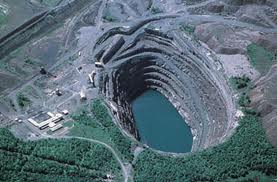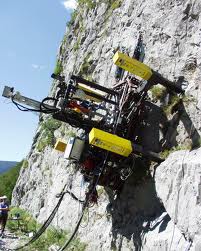What do we mine? In our last blog focused on exploration we talked about metallic and rare earth minerals. We didn’t focus on coal, or aggregate (gravel and construction materials). Nor did we talk about the mining of bitumen (oil or tar sands). But much of what we extract in mining includes all of these other materials.
Humanity has been extracting “stuff” from hillsides and pits for thousands of years. Mines pre-date the Neolithic Revolution by more than 30,000 years. From mines like the one that appears below to today the basic extraction technology has not significantly changed.

We have mined by finding resources on the surface. We have mined by digging tunnels and shafts into the ground. We have even recovered salt from the ocean using evaporation to harvest the mineral.
Currently surface mining is the predominant way we extract materials on this planet. Subsurface mining represents a small percentage of total mining activity. And today we are looking at mining the ocean floor. Let’s take a closer look at each of these mining technologies.
Surface Mining
Surface mining extracts 67.3 billion tons of raw material including metals, non-metals and coal annually. Of that amount 30 billion tons represents waste that is removed to get to the really valuable “stuff” that lies beneath. We quarry rock, sand and gravel to the tune of 23.5 billion tons for construction including 2.3 billion tons of material each year to for cement. Uncovering a mother lode and stripping out the ore has been and remains our most common mining technique to-date. In the United States, 98% of all metallic ores are extracted through surface mines. A typical surface mine is an open pit, a quarry or a stripped surface.
If you have never experienced a surface mine first hand it tends to overwhelm you. My first visit took place in 1965 when my high school class visited the open pit iron mine in Marmora, Ontario, about two hours northeast of Toronto. The mining company, Bethlehem Steel, had discovered a deposit of magnetite iron ore that was 33 meters (+100 feet) under the land surface, and therefore accessible by using open pit technology. To access the ore the company removed 73 million tons of limestone. The pit pictured below was a spectacular engineering feat. Its terraced sides served as a roadway upon which some of the biggest trucks I had ever seen crawled hauling raw ore excavated from the pit. I remember taking some sample magnetite home with me containing beautifully formed garnet crystals.

The ore body at Marmora was not large, spanning 850 by 220 meters (approximately 2,800 by 720 feet) and at its deepest reached 460 meters (1,500 feet) below the surface. It wasn’t highly concentrated iron either and therefore was crushed and pelletized as concentrate on site. You can see in the picture some of the processing buildings next to the open pit. At the time I first visited Marmora huge power shovels and bulldozers could be seen on the pit floor digging up raw ore. After 26 years the mine was no longer of any economic value and mining operations ceased. Today the abandoned mine sits like an open wound on the landscape slowly filling with water. Next to the pit lie mountains of waste material. One can find lots of Marmoras around the planet, abandoned pits accompanied by slag heaps, with little effort by the companies that did the mining and by the governments that granted mining licenses to do any environmental rehabilitation.
In the United States an even more extreme form of surface strip mining involves mountaintop removal. In 1998 the United States Department of Energy estimated that coal reserves in Appalachia amounted to 28.5 billion tons with much of it concentrated in Kentucky, West Virginia, Virginia and Tennessee. To get to these coal reserves companies have been applying for permits to blast the tops of mountains, disposing of the mining overburden in nearby valleys. Once the coal is removed the company plans include land reclamation and restoration. Many licenses have been granted in the past two decades but recently environmental concerns have slowed the pace of this type of mining. In January 2011, the United States’ Environmental Protection Agency vetoed a mountaintop removal permit being sought by one company in West Virginia. The reasons cited included concerns about environmental impact on water quality and aquatic life during the mining operation and after reclamation. Studies of other mountaintop mining operations showed that existing production and reclamation plans were contributing to environmental degradation that warranted a second look. This is just one example of what the future holds for surface mining in many developed countries.
In developing countries, however, the need to build infrastructure is driving exploration and the growth of surface mining with all its attendant environmental risks. In fact the United Nations estimates that by 2038 humans will extract 138 billion tons of materials from the Earth using surface mining techniques with much of the growth coming from the developing world.
Subsurface Mining
Subsurface mine operators sink shafts and dig tunnels in the Earth to reach buried ore deposits. Mines can be vertical shafts, horizontal tunnels, sloping shafts that can incline upward or downward or a combination of all of these depending on the shape of the ore body. Unlike surface mines that use big shovel and pail technologies, underground mining involves drilling, grinding, building underground rooms supported by pillars and shoring, removing ore, reshoring and following the ore face. Harder mined materials may require underground controlled blasting to get to the ore.
As high-grade ore deposits become harder to access subsurface mines are digging deeper into the Earth. This means more complex infrastructure for ventilation, temperature management and environmental safety, better and faster human transportation systems, the building of safe areas within the mine, and material transportation systems that provide rapid removal of mined ore and waste.
The deepest subsurface gold mines today in South Africa reach depths of 4,000 meters (over 13,000 feet or close to 2.5 miles). What is the environment like in deep mines? Temperatures of rocks exceed 60 Celsius (140 Fahrenheit). Slurry ice is pumped underground to cool the tunnel air to 29.5 Celsius (85 Fahrenheit). A mix of concrete, water and rock acts as an insulator within the walls of excavated areas to make the mine habitable.
Getting in and out of a mine at the depths we are describing can take well over an hour. In the event of an emergency mines are equipped with safety chambers (see the illustration below) for refuge.

The rescue of the 33 trapped men at the San Jose mine in Chile involved drilling a rescue bore hole to a depth of 680 meters (over 2,200 feet). In mines 6 times deeper think of the technology needed to save the lives of those trapped below.
Robotic Mining
As subsurface mining penetrates deeper into the Earth, and as mineral deposits become harder to access robots will not only be used to rescue trapped miners but will replace humans at the ore face. Robots in subsurface mining have significant advantages over us.

- They don’t need to breathe and can be hardened to withstand the temperatures, atmosphere, potential toxic gases and chemicals that human operators need protection from. Robots can operate in a mining area in which iInert gases are pumped to eliminate the risk of a subsurface fire. In coal mining this would be an enormous benefit.
- They are not constrained by the limitations of human anatomy and can be designed to navigate and work both horizontally and vertically and anywhere in between. Robots can be outfitted with multiple robotic legs for stability and arms holding specialized mining tools. Three, four, five or six hands are way better than two. Six feet or sixty gives a robot mobility options.
- They can be made small to fit small mineral seams. That means mining operators can excavate smaller tunnels with less stress to the surrounding rock from which the minerals are extracted. For those on the surface it means less chance of subsidence from a mining cave in.
- They can be used in remote mining locations where human habitation would be difficult. Think of mines in polar regions or off the planet’s surface.
- They can be controlled remotely or they can be networked to work cooperatively.
Humans will no longer need be exposed to the dangers of operating in the deep at the mine face, or be exposed to toxins leading to illnesses associated with long-term exposure to mining environments.
Ocean Mining
Exploiting the surface of the planet that lies underwater remains the next frontier for the mining industry. Just as oil and natural gas exploration moved offshore so will mining. Why?
Seafloor Massive Sulphide or SMS are deposits that form on the ocean floor near the edges of crustal plates. Associated with the hydrothermal vents known as “black smokers,” SMS deposits contain high concentrations of copper, zinc, gold, silver and other trace metals. They form when ocean water leaches into the cracks and rock fractures and undergos super-heating to a point where it dissolves the minerals in nearby rocks. When the super-heated water contacts the cold seawater above it the dissolved minerals precipitate on to the ocean floor creating massive deposits in the range of several million tons.
Companies and countries are just starting to exploit SMS laying claim to hundreds of thousands of square kilometers of the ocean floor. One company in Canada, Nautilus Minerals, is developing a project called Solwara 1 off the New Guinea coast.
What technology will humans need to develop ocean mining? The basic components already exist from technology developed for deep sea fossil fuel exploration and development. Robotic marine undersea technology can explore and mine SMS deposits. Piping systems and risers will serve as conduits for mined SMS combined with liquid to be pumped to the ocean surface for collection and processing.
Many countries are laying claim to SMS deposits. The following map illustrates the full extent of our 21st century mining future under the ocean.

Mining Off the Planet’s Surface
The 21st century will see our first efforts at mining near the Earth. From the moment that humans ventured to the Moon and Mars we have been studying their geological history, surveying their surfaces, creating radar and LIDAR images of subsurface terrain, identifying concentrations of mineral deposits, all with the idea of eventually inhabiting them.
When we finally begin to inhabit the Moon and Mars our first humans and robots will be miners seeking water for sustenance and for its byproducts, oxygen and hydrogen, then building materials for construction. The 21st century should see the first surface mining off our planet’s surface. Near-earth asteroids may become mining waystations to provide materials for constructing spaceships that will fly to Mars and beyond.
But we will look at space and the 21st century in much greater depth in an upcoming blog.
















[…] treaty provides game-changing protection for ocean ecosystems and places restrictions on deep-sea mining operations, already a cause for concern because of its potential impact on seafloor […]